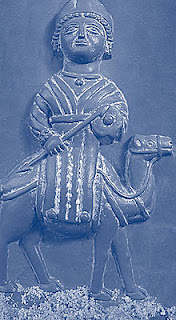The Goddess al-'Uzzá was the Goddess of love, war, and beauty, as well as of the morning and evening star. She is the daughter of Allah. She has two daughters and her consort is Dhu'Shara. In ancient times, al-'Uzzá was first a Sabaean and southern Arabian goddess, but Her cult spread to the Nabataeans in the north. Many people worshiped Her, including the Quraysh, Sulaym, Ghanim, Khuza'ah, Kinanah, Nabataeans, and Sabaeans. Her idol stood in a sanctuary called Buss, which contained an altar called al-Ghabghab and was used for sacrifices and prayers. Nearby to the temple stood three acacia trees in the Valley of Nakhlat al-Sha'miyah, near Makkah. She is similar to the Roman Goddess Venus, the Greek Goddess Aphrodite, the Canaanites Goddesses Ashtart and Anat, the Babylonian Goddess Ishtar, and the Sumerian Goddess Inanna.
•*´¨`*•.¸¸.•*´¨`*•.¸¸.•*´¨`*•.¸¸.•*´¨`*•.¸¸.••*´¨`*•.¸¸.•*´¨`*•.¸¸.•*´¨`*•.¸¸.•*´¨`*•.¸¸.•
Al-Lāt (Arabic: اللات) is a Pre-Islamic Arabic Mother Goddess who was one of the three chief goddesses of Mecca. The mother Goddess al-Lāt was actually the consort of the Pagan God al-Lah, who was the high God who created heaven and Earth. She is the mother of the God Dhu'Shara, and indeed she has many children. As for al-Lāt, She was the chief Goddess of the Banu Thaqif. She has the power to create life and give birth, and the Kaaba (cubic sanctuary) is sacred to Her as the creator of the deities. She is the Queen of Heaven for the Arabs, and in ancient times was worshiped by many people, including the Thaqif, Lihyan, Quraysh, Nabataeans, and Tadmorites. The Thaqif had the main idol and sanctuary for Her in the city of Ta'if, and an edifice was built over the idol. Al-Lāt's idols are in the shape of a cubic white rock, and offerings of barley porridge (sawiq) are prepared for her. She was called the "the Mother of the Gods." or "Greatest of All". She's a Goddess of springtime and fertility, and an Earth-Goddess who brings prosperity. Her symbol is the crescent the gold necklace she wears, and moon and star, something Islam used (though it's not used officially) after they destroyed the Pagan religions of the Middle East. There was a shrine and temple for Her in Ta'if, but during the violent attacks on the people of Ta'if by Mohammed, in order to force the Pagans to believe in the Islamic Allah, he destroyed Her shrine. Then he viciously forced the devotees of the Goddess to worship a misogynistic monotheistic god of a new religion. She was then delegated to being a daughter of the Islamic Allah by Mohammed, when pre-Islamic mythology actually considered al-Lah Her consort. She certainly isn't, and never was, a daughter of the Islamic Allah or Pagan al-Lah. She is also called Al-Lat, Allat, and Alilat. She has a lot in common with other goddesses like the Canaanite Goddess Asherah (called Elat), the Roman Goddess Minerva, the Greek Goddess Athena, and the Carthaginian Goddess Allatu.
 |
| Pre-Islamic Arabic Goddess Al-Lāt |
 |
| Pre-Islamic Arabic Goddess Al-Lāt |
•*´¨`*•.¸¸.•*´¨`*•.¸¸.•*´¨`*•.¸¸.•*´¨`*•.¸¸.••*´¨`*•.¸¸.•*´¨`*•.¸¸.•*´¨`*•.¸¸.•*´¨`*•.¸¸.•
Manāt
The Goddess Manāt is the wife of the God Hubal, daughter of Ruda, and the Goddess of Fate. Manāt was worshiped by many different tribes, including the Khazraj, the Aws, the Nabataeans, the Hudhayl, and the Khuza'ah. She is the most ancient of the three Goddesses discussed. She is the Goddess of time, destiny, fate, divination, and She leads heroes to the grave. At the end of the required pilgrimage, the Arabs would visit Manāt's shrine and shave their heads.
The Goddess Manāt is the wife of the God Hubal, daughter of Ruda, and the Goddess of Fate. Manāt was worshiped by many different tribes, including the Khazraj, the Aws, the Nabataeans, the Hudhayl, and the Khuza'ah. She is the most ancient of the three Goddesses discussed. She is the Goddess of time, destiny, fate, divination, and She leads heroes to the grave. At the end of the required pilgrimage, the Arabs would visit Manāt's shrine and shave their heads.


No comments:
Post a Comment
Comments? Questions? Please show class and respect in your comments. All comments are previewed, but anyone can comment. I welcome your comments!